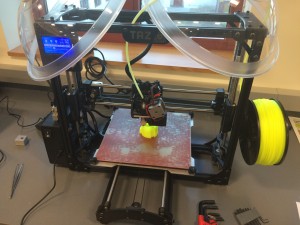CI’s Disruptive Manufacturing

We often hear that this invention or that tech will be a game changer or birth some new industry or other. These missives come so often we can become blasé about even the idea. At the risk of being like so many other rah-rah overhypers, the technology we know as 3D printing is already changing the world.
A New Way To Print
3D printing or additive manufacturing is a process of making three dimensional solid objects from a digital file. The creation of a 3D printed object is achieved using additive processes. In an additive process an object is created by laying down successive layers of material until the entire object is created. Each of these layers can be seen as a thinly sliced horizontal cross-section of the eventual object.
Our current default 3D printing technology involves a computer controlled emitter of stuff (usually primed with plastic, but metal, wood + resin, plant-based polymers, and food such as chocolate are all possible options) that moves about over an X-Y plane laying down precise amounts of the printed material under computer control. Once a given slice or plane of material has been laid down and hardened, the emitter is lifted up ever so slightly and repeats the process. This is all under computer control with the printer creating in real space the target model held in the computer’s memory.
Leveling the Machining Playing Field
Our array of 3D printers in the AARR laboratories allow us to print replacement parts of create new capabilities by generating new parts we have brainstormed. Rather than sending some schematic off to the engineering department or a machine shop that would take weeks and weeks to produce something for hundreds or thousands of dollars, we can print our needed piece for a few cents over the course of a few minutes (or hour or two depending upon the size).
With this tech we have created, revised, and improved a whole host of underwater and aerial robots. Our Lulzbot printer cost less than $3,000 and yet has brought an amazing amount of manufacturing parity to our program, effectively equivalent to having a well-equipped CNC machine shop that would have cost many hundreds of thousands of dollars (or more) only a couple of years ago. We can now produce robotic units that rival or surpass those from much wealthier and better resourced programs around the country. This is exactly the phenomenon we have seen with cell phone technology across much of the globe. In the late 1990s the developed world boasted the best telecommunications systems in the world. Now the developed world (especially the United States) is the backwater with most developing economies have massively better, cheaper, and faster telecommunication networks. Those countries often have essentially no landline phone networks to speak of. So assembling cell phone networks and proliferating telecom service providers was easy and unimpeded. Now every sheepherder I meet in eastern Turkey has a cell phone with signal reception usually better than what we are afforded in our laboratory building. In the case of 3D printing, we here at CI had nothing and so jumping on the latest tech was easy. At most of our more established university campuses in the U.S. and beyond, there is way too much investment in traditional machining and machining technologies to simply pivot to the new and improved world of 3D printing. So they are staying with the AT&T model of slow speed, insanely overpriced services, sloth-like innovation speeds, and crappy products.
The Next Wave
The future of 3D printing includes optically printed objects created at speeds much faster than our current tech, an ever-more diverse array of materials comprising the printed objects, and a much greater complexity of the tissues comprising the printed object.
